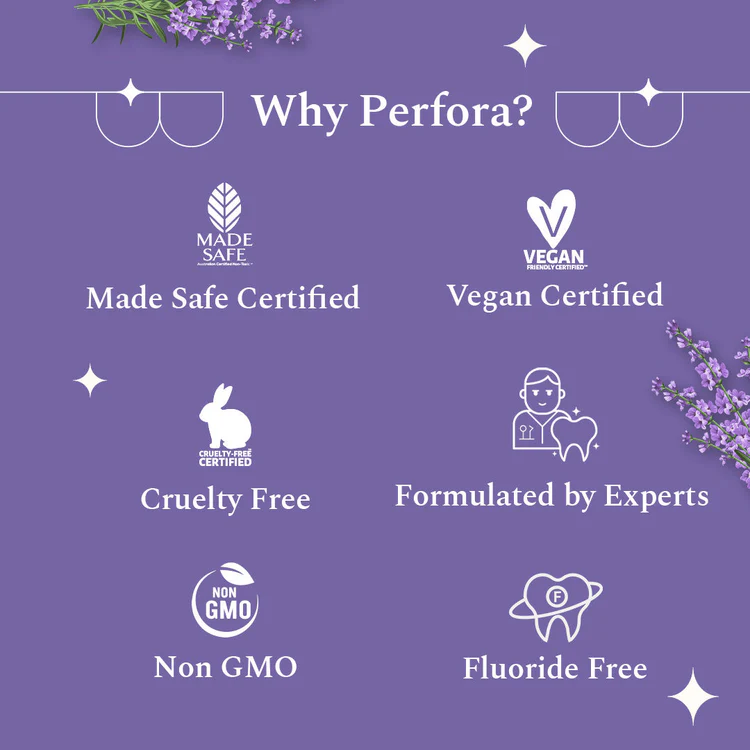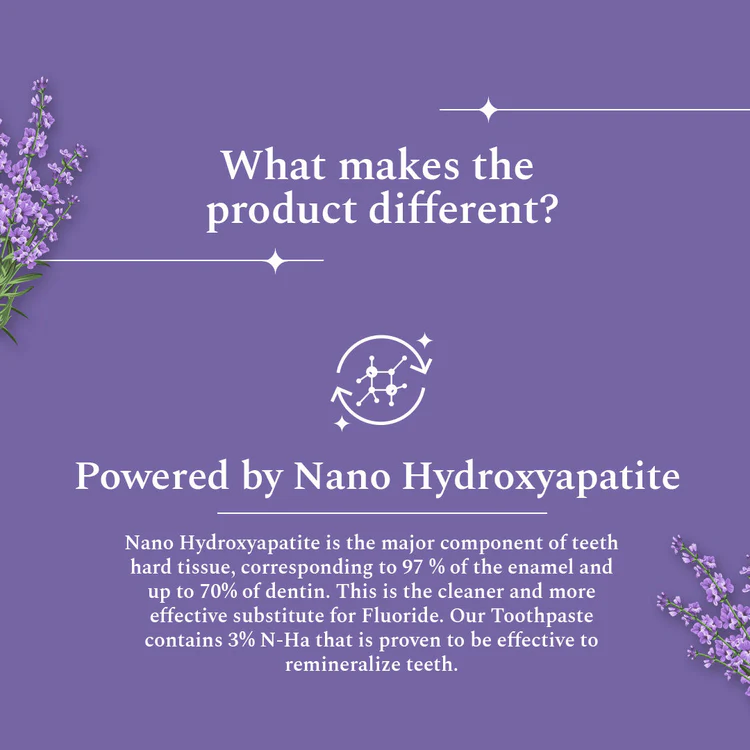Natural Oral Care, Toothpaste
Unwind – Lavender Rose Toothpaste
₹299.0
- Soothing delight with a combination of chamomile, strawberry, and cinnamon extracts
- Formulated with Nano Hydroxyapatite (n-HAp) for powerful remineralization
- Sodium bicarbonate to effectively whiten the teeth
- Description
- Additional information
- Reviews (0)
- Q & A
- Sustainability Remark
- More Offers
- Store Policies
- Inquiries
| Weight | 0.1 kg |
|---|
You must be logged in to post a review.
Q & A
Ask a question
There are no questions yet
The sustainability and low carbon footprint of the Lavender Rose Toothpaste can be attributed to several factors. Here are some key points with scientific explanations and justifications:
1. Natural and Organic Ingredients
- Justification: Lavender Rose Toothpaste may use natural and organic ingredients, which often require fewer resources and less energy to produce compared to synthetic alternatives.
- Scientific Explanation: Organic farming practices reduce the use of synthetic pesticides and fertilizers, which are energy-intensive to produce. This lowers the overall carbon footprint of the ingredients.
2. Eco-friendly Packaging
- Justification: Sustainable packaging materials, such as biodegradable or recyclable materials, help reduce waste and the carbon footprint associated with disposal.
- Scientific Explanation: Biodegradable materials break down more quickly and safely in the environment, reducing long-term waste. Recycling reduces the need for new raw materials, thus conserving energy and lowering emissions.
3. Local Sourcing of Ingredients
- Justification: If the ingredients are sourced locally, this reduces transportation emissions, contributing to a lower carbon footprint.
- Scientific Explanation: Transportation, especially over long distances, is a significant contributor to greenhouse gas emissions. Local sourcing minimizes these emissions.
4. Energy-efficient Manufacturing Processes
- Justification: Implementing energy-efficient manufacturing processes reduces the energy consumption and associated carbon emissions.
- Scientific Explanation: Advanced manufacturing techniques and renewable energy sources can significantly cut down on the energy used during production, thereby lowering the carbon footprint.
5. Reduced Water Usage
- Justification: Efficient use of water in the production process conserves this vital resource and reduces the energy required for water treatment and distribution.
- Scientific Explanation: Water usage and treatment require significant energy. By reducing water usage, the product indirectly lowers its carbon footprint.
6. Minimal Use of Harmful Chemicals
- Justification: Avoiding harmful chemicals in the formulation reduces the environmental impact and energy required to produce and neutralize these substances.
- Scientific Explanation: The production and disposal of harmful chemicals can be energy-intensive and environmentally damaging. Using safer, natural alternatives helps mitigate this impact.
- Raw Material Extraction and Processing (40-50%)
- Explanation: This includes the cultivation or extraction of natural ingredients, which may have a lower impact compared to synthetic chemicals but still contribute significantly due to agricultural practices and processing.
- Manufacturing (20-30%)
- Explanation: Energy consumption in the manufacturing process can be substantial, although energy-efficient practices and the use of renewable energy can reduce this percentage.
- Packaging (10-20%)
- Explanation: The production and disposal of packaging materials contribute to the carbon footprint. Sustainable packaging options can significantly lower this impact.
- Transportation (5-15%)
- Explanation: This covers the emissions from transporting raw materials to the manufacturing site and the finished product to the consumers. Local sourcing helps to minimize this portion.
- End-of-life (5-10%)
- Explanation: This includes the disposal or recycling of the product and its packaging. Biodegradable and recyclable materials help reduce the carbon footprint at this stage.
Example Calculation
Assuming the Lavender Rose Toothpaste uses best practices in sustainability, here’s a possible percentage breakdown:- Raw Material Extraction and Processing: 40%
- Manufacturing: 25%
- Packaging: 15%
- Transportation: 10%
- End-of-life: 10%
Justification
- Raw Materials: Organic and natural ingredients typically have a lower carbon footprint but still account for a significant portion due to agricultural activities.
- Manufacturing: Energy-efficient practices and renewable energy use can reduce this percentage.
- Packaging: Using biodegradable or recyclable materials can lower the impact, but it still remains a notable contributor.
- Transportation: Local sourcing can minimize transportation emissions, keeping this percentage lower.
- End-of-life: Effective waste management and recycling initiatives can reduce the carbon footprint from product disposal.
References and Studies
- Life Cycle Assessment (LCA) Studies: LCAs of organic and natural personal care products often show a reduced environmental impact compared to conventional products. These studies analyze the entire lifecycle from raw material extraction to disposal.
- Renewable Energy in Manufacturing: Research from the International Renewable Energy Agency (IRENA) highlights how renewable energy sources in manufacturing can significantly reduce carbon footprints.
- Sustainable Packaging: Studies published in the Journal of Cleaner Production detail the benefits of biodegradable and recyclable packaging on reducing waste and emissions.
- Local Sourcing and Transportation: The Environmental Protection Agency (EPA) provides data showing the carbon savings from reduced transportation distances for locally sourced products.
No more offers for this product!
General Inquiries
There are no inquiries yet.










165824557099530.jpg?v=1658245573)
















Reviews
There are no reviews yet.